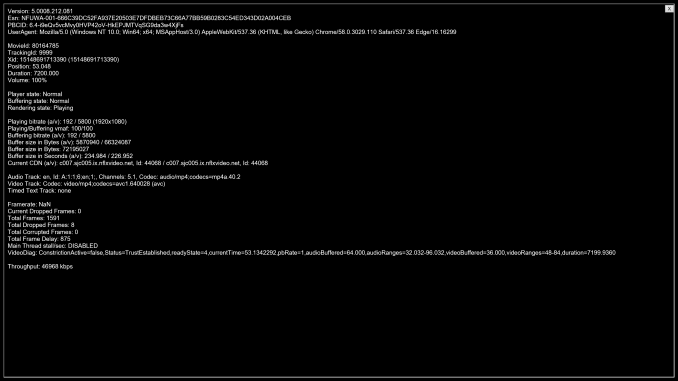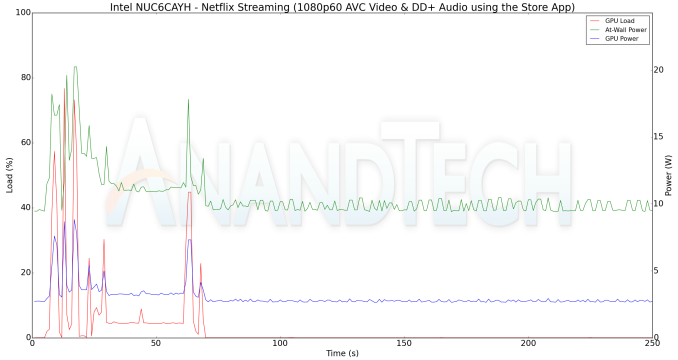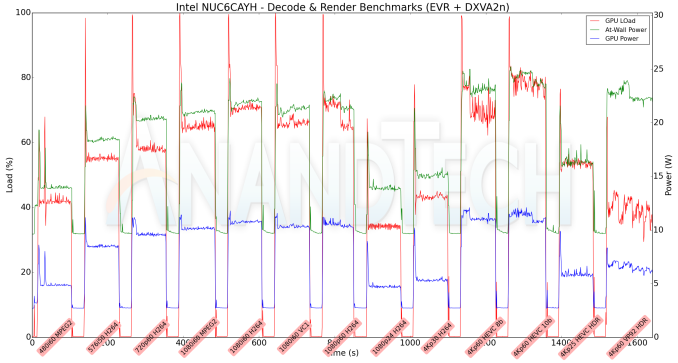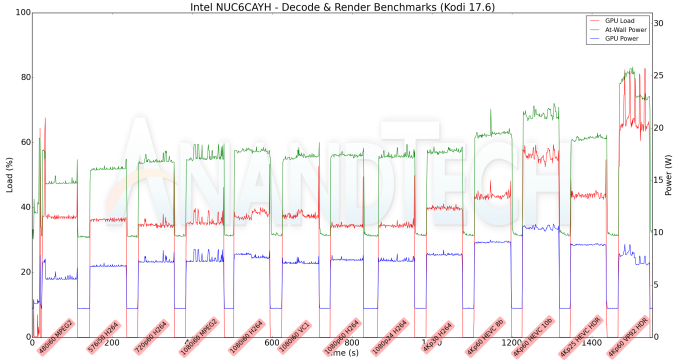Intel NUC6CAYH (Arches Canyon) Apollo Lake UCFF PC Review
by Ganesh T S on January 12, 2018 8:00 AM EST- Posted in
- Systems
- Intel
- NUC
- UCFF
- Apollo Lake
- Arches Canyon
4K HTPC Credentials
The Intel NUC6CAYH is actively cooled, but the fan curves are quite good. We were barely able to hear the fans at a distance of 6 ft. While not being as good as fanless unit with respect to acoustics, the NUC6CAYH fits the bill for a secondary / bedroom HTPC.
Refresh Rate Accuracy
Starting with Haswell, Intel, AMD and NVIDIA have been on par with respect to display refresh rate accuracy. The most important refresh rate for videophiles is obviously 23.976 Hz (the 23 Hz setting). As expected, the Intel NUC6CAYH has no trouble with refreshing the display appropriately in this setting.
The gallery below presents some of the other refresh rates that we tested out. The first statistic in madVR's OSD indicates the display refresh rate.
Network Streaming Efficiency
Evaluation of OTT playback efficiency was done by playing back the Mystery Box's Peru 8K HDR 60FPS video in YouTube using Microsoft Edge and Season 4 Episode 4 of the Netflix Test Pattern title using the Windows Store App.
The YouTube streaming test played back the 4K non-HDR version (VP9 video and Opus audio), while the Netflix one delivered the 1080p 5.8 Mbps AVC version.
The graph below shows the power consumption at the wall and the GPU loading parameters for the YouTube streaming case. Initially, the power consumption is a bit high as the video is fetched at a lower resolution (less taxing overall), but, needs to be scaled up for display. Later on, as the buffering stabilizes, the power consumption of the system (around 14W) and the GPU power (around 4.5W) settle down.
A similar graph for the Netflix streaming case is also presented below. Manual stream selection is available (Ctrl-Alt-Shift-S) and debug information / statistics can also be viewed (Ctrl-Alt-Shift-D). Statistics collected for the YouTube streaming experiment were also collected here. Despite the availability of a 4K display and HCP 2.2 support, I couldn't get Netflix to play back the 4K version of the title, even though the Apollo Lake NUC is supposed to be able to do it. On a hunch, I went back from the Fall Creators Update to the much older Anniversary Edition. That time around, I got the ULTRA HD 4K tag on the title, but, the playback was still that of the 1080p version 1080p, with the 4K stream option not visible at all.
It must be noted that the debug OSD is kept on till the stream reaches the 5.8 Mbps playback stage around 1.5 minutes after the start of the streaming. Toggling the state of the debug OSD results in variation in the at-wall power consumption (as much as 3W) and GPU loading parameters. In the steady state, we find that the at-wall and GPU power numbers are around 10W and 2.7W respectively.
Decoding and Rendering Benchmarks
In order to evaluate local file playback, we concentrate on Kodi and MPC-HC with EVR for the two systems. The integrated GPUs are too weak to handle madVR. We recently revamped our decode and rendering test suite, as described in our 2017 HTPC components guide. For the purpose of testing, we utilized Kodi 17.6, MPC-HC x64 1.7.13, and LAV Filters 0.70.1-83. The video decoder was set to native DXVA2 mode.
Playing back the SD and 1080p streams at 4K requires scaling, and that shows in the power numbers of the above graph. One point to note is that Apollo Lake does not support VP9 Profile 2 decoding, and the playback of the final stream in the above test suite was essentially a slideshow.
We see similar behavior with Kodi 17.6, as shown in the graph below.
Kodi turned out to be much better than MPC-HC, and we were happy to note that all streams except the VP9 Profile 2 one played back without any frame drops or stutters.
Finally, it must be noted that the GPU inside the Apollo Lake SoC does not support UHD Blu-ray playback despite the presence of a HDCP 2.2 HDMI 2.0 port. The SoC does not have SGX capabilities either.






















54 Comments
View All Comments
Badelhas - Monday, January 15, 2018 - link
Such a coincidence, I bought the NUC6CAYS two days ago, to use it has a HTPC, but I´ve been having multiple issues. One of the reasons I bought this was because it has a SPDIF Toslink Optical port, so I though I could connect it to my Home Cinema and have 5.1 digital sound but that dosent happen, I can only get PCM (stereo) sound. I have all Intel drivers installed, does anybody have a clue why this is happening?I also been having much trouble updating Windows 10 to the Fall Creators Update since it says I dont have enough space, which is incredible.
Cheers
Macpoedel - Monday, January 15, 2018 - link
Are you using software that supports audio passthrough, and are you playing videos that have Dolby Digital 5.1 or DTS encoded audio tracks (probably otherwise you wouldn't be asking)?I have a NUC6CAYH and have no problems passing through DTS(-HD) from Kodi 17, but I do so over HDMI.
Badelhas - Thursday, January 18, 2018 - link
I am playing movies with 5.1 and it doesn't work. But the problem comes before even playing the movie. The moment I connect my Sony Home Cinema to my main PC though the Optical out port on the Asus DX Sound-card the home cinema changes from "PCM" to "DIGITAL", showing me that it is working. When I do this with the Intel NUC it doesn't, even selecting Digial Out on the Windows or Realtek Sound settings. Very disappointing, to be honest, and Intel Community administrators have been of no help on their forums...mode_13h - Monday, January 15, 2018 - link
"The Celeron J3455 is a quad-core processor with a 10W TDP. It easily enabled the NUC6CAH to come out on top in all of our benchmarks when compared against other Atom-class systems."Actually, I imagine the combination of dual-channel memory and a desktop-class SSD might've been bigger factors.
mode_13h - Monday, January 15, 2018 - link
BTW, thanks for this review. I'm very interested in such low-power systems.However, I was quite disappointed to see no i3 desktop-class system used in any of the comparisons besides the first. It's relevant and important to know how much performance one is sacrificing, when going with a low power "Atom-class" CPU. It would've been appreciated and appropriate at least to include the next higher model of NUC.
I hope that you address this if/when you review a Gemini Lake NUC.
Badelhas - Thursday, January 18, 2018 - link
This is not an Atom but a Celerom, much better.mode_13h - Thursday, January 18, 2018 - link
At the end of the day, those are just brand names. Both are still in use, actually, but I was referring to its lineage.IMO, highlighting it as a "Celeron" muddies the waters, since Intel has shipped Celerons with mainstream (e.g. Skylake) cores, yet this uses the low-power Goldmont core.
nevcairiel - Tuesday, January 16, 2018 - link
I would've liked performance comparisons to the previous generation NUC in the same price class, ie. the one this one replaces. Seeing the clear generational gain would've been sweet.Macpoedel - Wednesday, January 17, 2018 - link
The previous generation low-end NUCs had mobile Braswell CPU's (NUC5CPYH had a Celeron N3050 and NUC5PPYH had a Pentium N3700). It's not exactly the same, but the AsRock Beebox N3000 is a pretty good approximate for the N3050 NUC, it's also a dual core and the burst clock speed isn't that much lower.The NUC6CAYH is more of a successor to the NUC5CPYH in pricing, but the Celeron J3455 in this NUC performs more like the Pentium based predecessor, so the gains are pretty big. You can see that it's twice as fast in a lot of benchmarks, mostly because the amount of cores doubled. Power consumption has gone up as well, but that's also because the newer NUC's CPU has a greater power envelop, so it'll spend more time at boost speeds.
But, having a NUC6CAYH myself, I was a bit disappointed with the performance. It's totally adequate for use as a HTPC or as a low power desktop (if you only edit documents or surf some webpages, but don't multitask too much), but the Core based NUCs are a lot faster (the i3 version costs twice as much though, I would be interested in a Kaby Lake Celeron based NUC like the original Sandy Bridge NUC).
mikato - Wednesday, January 17, 2018 - link
Now we really need an AMD Zen APU UCFF to compare. Is Zotac making a Zbox with one when they come out maybe?